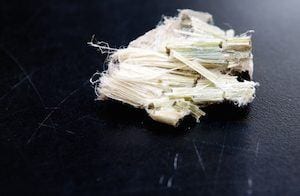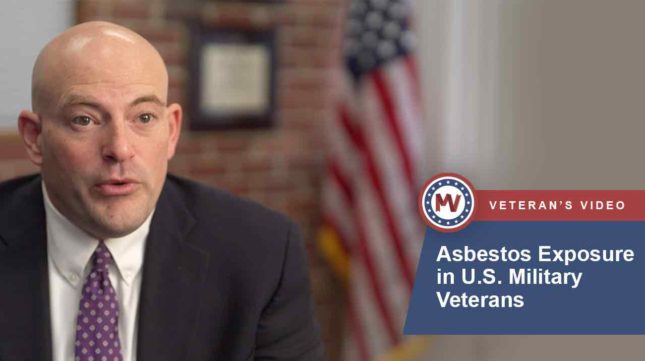What Is Asbestos?
Asbestos is a naturally found mineral made up of very strong and tiny fibers. It's also a known carcinogen (cancer-causing substance) and has been linked to deadly health problems, including malignant mesothelioma.
However, asbestos was once considered safe to use in hundreds of products. It was a good insulator, cheap, and fire-resistant, so some considered it a "miracle" substance.


The asbestos industry learned of the dangerous health effects asbestos posed in the 1930s, but it suppressed the truth for decades to keep profits up. In the process, millions of people were put at risk of asbestos-related diseases.
About 3,000 people — including workers, U.S. veterans, and their family members — develop mesothelioma every year due to asbestos exposure.
Thankfully, those affected can secure financial aid and health care benefits from the U.S. Department of Veterans Affairs (VA) and private sources.
Asbestos in the U.S. Military
Before the dangers were well-known, the U.S. armed forces used asbestos in every military branch. One-third of mesothelioma victims are U.S. veterans as a result.
The U.S. military used asbestos in:
- Cars
- Bases
- Building materials
- Planes
- Ships
- Weapons
Due to government mandates, all U.S. Navy ships and submarines were built with asbestos prior to the early 1980s, as it was a good insulating material and fireproofing agent. However, it also put U.S. Navy veterans at a higher risk of mesothelioma than veterans of other branches.
Steps have since been taken to remove asbestos from U.S. military assets and help affected veterans. Today, U.S. veterans with mesothelioma and other asbestos-related diseases can file for VA benefits to get free medical care and monthly financial payouts.
Asbestos-Related Diseases
Asbestos exposure can lead to many health problems 10-50 years after exposure.
"When the [asbestos] mineral fibers are handled, they can be released into the air and be inhaled, because of their microscopic size and fibrous nature, which can lead to asbestos accumulating in the lungs and causing respiratory illness."
— National Institute for Occupational Safety and Health
The most notable asbestos-related disease is mesothelioma. Almost all cases of mesothelioma are linked to asbestos exposure, according to the U.S. Centers for Disease Control and Prevention (CDC). Mesothelioma can develop if asbestos fibers get stuck in the linings of major organs, including the lungs, abdomen, heart, or testicles.
Other asbestos-related diseases include:
- Asbestosis (an incurable lung disease)
- Colorectal cancer
- Lung cancer
- Ovarian cancer
- Pleural plaques (buildups of collagen in lung lining)
Those at the greatest risk of asbestos-related diseases were exposed on a regular basis at a job, according to the National Cancer Institute (NCI).
While most of these asbestos-related diseases are life-threatening, you and your family may qualify for low-cost or free treatments and financial aid offered as part of VA benefits.
Types of Asbestos
There are six different types of asbestos fibers. All types can cause mesothelioma, according to the Occupational Safety and Health Administration (OSHA).
The types of asbestos include:
- Actinolite: This dark-colored fiber consists of straight needles. It was often mixed with vermiculite, another mineral, to make insulation. It was also used to make paint and drywall.
- Amosite: This is a type of asbestos that was mainly mined out of South Africa. It has straight and short fibers. It was previously used to make products for construction.
- Anthophyllite: This is a rarer type of asbestos that can be mined in Georgia, North Carolina, and Finland. The fibers come in several types of colors, including yellow and brown. This type was used in cement and insulation but wasn't as commonly used as some of the other types.
- Chrysotile: This is far and away the most common type of asbestos. Up to 90% of all asbestos used in the U.S. was chrysotile asbestos. It is made of long and curly fibers. It was once believed to be non-toxic, but researchers have found that it is just as carcinogenic as other asbestos types.
- Crocidolite: This type isn’t as heat-resistant as other types of asbestos, so it wasn’t used as often in industrial products. However, it is the most toxic of all asbestos types because it has very slender fibers that travel easily throughout the body.
- Tremolite: This type resists heat well and was used in many products, including paint, fabrics, insulation, roofing materials, and sealants. The fibers can vary in color, ranging from dark green to white.
The different types of asbestos fibers fall into one of two main groups: the serpentine group and the amphibole group.
Chrysotile asbestos is the only type that belongs to the serpentine group. The fibers in this group are curly. All other types fall into the amphibole family as their fibers are sharp and straight.
Friable Asbestos
Asbestos can be friable or non-friable. Friability describes substances that crumble easily. Friable asbestos can be broken apart just by touching it. Non-friable (or “bonded”) asbestos products are sturdier. Bonded asbestos products are made up of asbestos fibers mixed with substances like cement.
Some friable products are 100% asbestos. Asbestos only makes up about 15% of non-friable products.
Friable asbestos products are more dangerous as the fibers can become airborne with little to no effort. Simply touching a friable product can release toxic asbestos dust and fibers into the air. Old or damaged non-friable asbestos products can also release fibers.
High-Risk Asbestos Occupations
Besides U.S. veterans, there are dozens of different kinds of jobs that have exposed employees to asbestos throughout the years. Workers at high-risk asbestos jobs were in contact with insulation and other products that contained asbestos on a regular basis.
Occupations with a high risk of asbestos exposure include:
- Carpenters
- Construction workers
- Electricians
- Painters
- Pipefitters
- Shipyard workers
- Steamfitters
- Textile workers
Men made up most of these workers, which is why men have a higher risk of mesothelioma today.
However, family members could also have been put at risk through secondhand asbestos exposure. Asbestos fibers could stick to workers' hair, skin, and clothing. Thus, family members and loved ones could have been exposed when the workers returned home.
List of Asbestos-Containing Products
Asbestos was used in more than 3,000 products up through the early 1980s since it was strong, heat-resistant, and cheap. The CDC notes that these products were using asbestos before scientists learned of the health risks.
Asbestos-containing products included:
- Adhesives
- Boilers
- Brake pads
- Caulking
- Cement
- Cigarettes
- Furnaces
- Floor tiles
- Gaskets
- Insulation
- Plumbing fixtures
- Shingles
- Talc
- Toothpaste
Because the risks weren't fully known, most people who worked with or around these asbestos-containing products were never given protective equipment.
The History of Asbestos
Asbestos has been used for thousands of years, dating back to Egypt in 3,000 B.C.In the late 1800s, the industrial revolution sparked the use of asbestos in many different products. But soon, the harmful effects of asbestos surfaced. The first death linked to asbestos was reported in 1906.
By the early 1930s, the asbestos industry had proof that asbestos was harmful to human health, but leading companies like Johns-Manville hid this evidence so they could keep making money.
It wasn't until the 1970s that the dangerous truth about asbestos became widespread public knowledge. By the early 1980s, the first lawsuits had been filed against the asbestos industry and the material was heavily restricted — but not fully banned.
Banning Asbestos
More than 70 countries in the world have banned the use of asbestos due to its toxicity. However, asbestos is still not fully banned in the United States.
In 1989, the U.S. Environmental Protection Agency (EPA) passed a rule banning asbestos, but much of it was overturned two years later.
“Though it acknowledged that asbestos in any amount caused cancer, in 1991 the U.S. Court of Appeals for the Fifth Circuit threw out most parts of the EPA’s rule, saying the agency failed to prove that a ban was the ‘least burdensome alternative’ for controlling the public’s exposure.”
— Environmental Working Group
Roughly 320 tons of asbestos were imported from Brazil to the United States in 2021 alone. The EPA is currently looking into banning all ongoing uses of asbestos.
Other countries, including China, Brazil, Russia, and India, continue to use asbestos with little to no bans in place. About 255,000 people in the world die from asbestos exposure each year, according to the International Journal of Environmental Research and Public Health.
Asbestos Abatement
Asbestos abatement is the process of sealing and/or removing products containing this harmful substance. Though it may sound concerning to leave asbestos-based products in place by repairing or sealing them, it is a very safe process when done professionally.
Major asbestos abatement efforts began in the early 1980s. Notably, many U.S. military bases, vehicles, and ships were abated to prevent more service members from being exposed. Removal of asbestos was common, but some products remained behind if they were safely sealed and wouldn't put anyone at risk.
Today, asbestos abatement professionals work across the country to help people deal with asbestos that may still lurk in older buildings, ships, and vehicles.
- If you live in a home with asbestos-containing materials, the Agency for Toxic Substances and Disease Registry (ATSDR) recommends avoiding it and talking to a licensed professional to get it inspected.
- Speak up if you're concerned that your job could be exposing you to asbestos. Construction work, plumbing, and electrical work on older buildings could come with a risk of exposure. Asbestos should be safely sealed or removed before starting work on an older structure.
- Licensed professionals can conduct asbestos testing and recommend ways to protect you and others from being exposed to this dangerous substance.
Generally speaking, asbestos-containing products that are sturdy don't need to be removed, but those that are damaged and friable do.
Help for Those With Asbestos-Related Diseases
You need to find a specialist if you've been diagnosed with mesothelioma or another asbestos-related disease. Top doctors can recommend treatments that will help you live as long as possible.
Further, U.S. veterans may be entitled to many medical and financial benefits following a diagnosis.
These benefits include:
- Free health care or reduced copay through the VA
- Treatments from top mesothelioma doctors
- VA disability compensation (often worth $3,800+ a month)
- Access to asbestos trust funds and private compensation claims
Find out how to access your mesothelioma VA benefits now with our team's help.
Common Questions About Asbestos Exposure
How do you get exposed to asbestos?
The most common way asbestos exposure happens is at a job or during military service. Many industrial jobs (like construction work) relied on asbestos-based products before the early 1980s.
Exposure can also happen at home. Many homes built prior to the early 1980s used asbestos-based insulation. Asbestos can also be found in homes that contain certain types of roofing, floor tiles, appliances, and more.
Renovating older homes can release asbestos into the air. This can cause exposure to family members. There are professional companies that specialize in safe asbestos removal.
Is asbestos still used in homes?
Asbestos may be present in older homes, especially those built before the 1980s. However, most construction materials used to build homes today do not contain asbestos.
Why is asbestos dangerous?
All forms of asbestos are dangerous because the fibers can get stuck in your body and cause health problems like cancer to develop 10-50 years after you are exposed.
Unfortunately, those exposed decades ago were unaware of the risks because major companies hid the truth.
Does asbestos turn into cancer?
Asbestos may cause cancer in some people. If asbestos dust or fibers are inhaled, they can irritate tissues in the body and cause cancerous mutations to form.
What are symptoms of asbestos exposure?
You won't have any asbestos symptoms unless you're sick, and not everyone exposed to asbestos will become ill.
Further, the symptoms of asbestos-related diseases can vary depending on which illness or illnesses you develop.
Common symptoms of asbestos-caused mesothelioma and lung cancer include:
- Chest pain
- Coughing up blood
- Shortness of breath
If you have any possible symptoms of mesothelioma or another asbestos-related disease, see a doctor immediately. Tell them about your current symptoms, when they started, and if you were ever exposed to asbestos.
Is asbestos banned in the U.S.?
No, asbestos is not currently banned in the United States. A ban was proposed in 1989 but overturned in 1991. However, asbestos use is heavily limited and the EPA is currently working to ban this deadly substance once and for all.
Where is asbestos found?
Asbestos is a naturally occurring mineral, so it can be found in mines and rock deposits across the world. However, asbestos mining has been banned or greatly restricted in many countries due to the risks.
Many older buildings, vehicles, ships, and products may still contain asbestos, though. Brake pads, insulation, and floor tiles are some of the many older products that might have asbestos in them even today.



